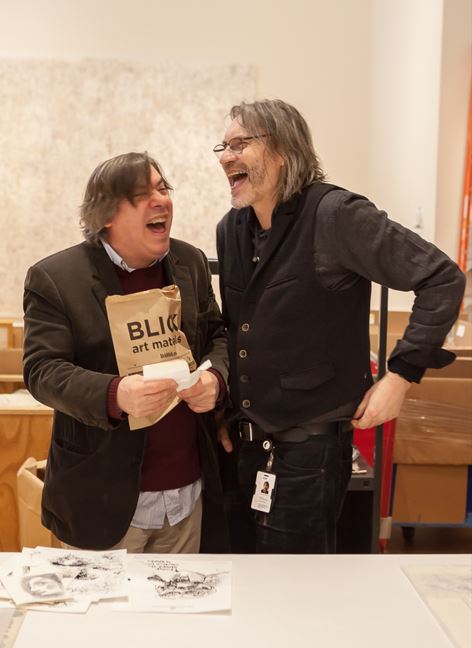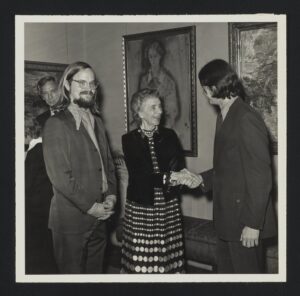I know I am not alone in being depressed and appalled by the erosion of women’s rights in this country and around the world. Rape is used as a tool of power, terror, and abuse in war zones in Europe and Africa. Women are forced from their jobs and girls are turned away from schools in Afghanistan. In the US court rulings and new legislation strip control of reproductive and health decisions from women. The current atmosphere of intolerance encompasses legislation negatively impacting LGBTQ+ individuals, and the banning and censoring of books, to mention just two more troubling issues.
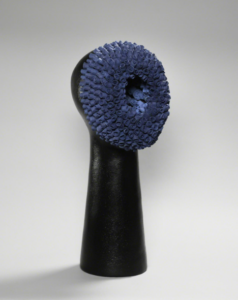
Simone Leigh, No Face (Crown Heights), 2018, Terracotta, graphite ink, salt-fired porcelain, and epoxy, 20 in x 8 in; 50.8 cm x 20.32 cm, Director’s Discretionary Fund, 2019
In my role as Director of The Phillips Collection, I want to share some thoughts about these troubling issues, and how our museum reflects and embraces our mission driven values of diversity, equity, access, and inclusion that are so boldly stated in our strategic plan, crafted and adopted by staff and board leadership, and that continues to guide our work in all ways. Our diversity values impact our workforce, our hiring, our institutional culture, our board of trustees, our collecting policies, the focus of our exhibitions and programs in the museum and in the community.
Our collecting policy explicitly embraces adding diverse voices—people of color and women. I want to mention just a few of the women that are now represented in our collection, acquired within the past ten years or so (by no means intended as a comprehensive list): Jae Ko, Kate Shepherd, Arlene Shechet, Zilia Sánchez, Nekisha Durrett, Ranjani Shettar, Nara Park, Zoë Charlton, Renée Stout, Marta Pérez García, Mequitta Ahuja, Janet Taylor Pickett, Barbara Liotta, Regi Müller, Tayo Heuser, Linn Meyers, Alyson Shotz, Jean Meisel, Jennifer Wen Ma, Helen C. Frederick, Bettina Pousttchi, Jeanne Silverthorne, Sandra Cinto, Julia Wachtel. I have been true to this goal of diversification in many of the purchases made with the Director’s Discretionary funding including works by Simone Leigh, Dindga McCannon, and the complete portfolio of the Guerilla Girls.
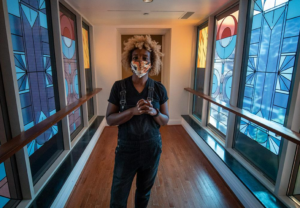
Nekisha Durrett with her artwork Airshaft (2021) in the bridges of The Phillips Collection. Photo: Brendan Canty
Many of these artists were featured in Vesela Sretenović’s Intersections exhibition series that was inaugurated in 2009, or from projects curated by Klaus Ottmann or Adrienne Childs, among others. The acquisition of the work by Zilia Sánchez resulted from the major monographic exhibition that Vesela organized in 2019 that traveled to New York and Ponce. Our exhibition of the Debra and Dennis Scholl collection of contemporary Australian Aboriginal women artists resulted in a stunning gift of six ceremonial poles. Marta Pérez García’s work entered the collection from our centennial community juried exhibit Inside Outside Upside Down, (curated by Elsa Smithgall and Camille Brown with Renée Stout) an introduction that resulted in her current Intersections exhibition Restos-Traces.
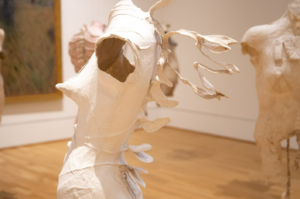
Marta Pérez García, Restos-Traces, 2021-2022, photo by AK Blythe
Our programming has also reflected women’s rights issues. Programs can be platforms for learning, exchange, and participation. In 2018 we mounted a solo installation by Australian artist, Halcyon fellow, Georgia Saxelby, To Future Women. Installed at the one-year anniversary of the Women’s March of January 2017, this project involved a community making, participatory letter writing activity, resulting in a time capsule of hundreds of expressions of anger, hope, sorrow, and solemn reflection. On February 14, 2018, Violence Against Women Day, we staged a panel discussion that brought an array of voices to the stage. How appropriate that this summer we have hosted Marta Pérez García’s powerful and disturbing Restos-Traces exhibition that confronts us with the resilience and strength of women who have survived domestic violence. Later this month, as the exhibition reaches its conclusion, programming will allow our communities to convene for further discussion, growth, and healing. In addition, I recall the 2020 annual Artists of Conscience Forum with the theme of “Women, Race and Representation,” celebrating the creativity of women highlighted throughout the Intersections series.
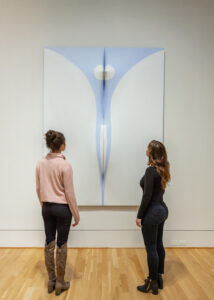
Installation image of Zilia Sánchez’s Juana de Arco (Joan of Arc), 1987
In 2020 we engaged in a heated debate about whether to install Black Lives Matter banners on our façade. We heeded the advice of then Chief Diversity Officer, Makeba Clay, that we should first “show the receipt,” and kept on doing our work towards diversity and inclusion, rather than making a performative gesture. Later that year we installed a work by conceptual artist Jenny Holzer which included two large banners “Moral Injury” and “So Vote.” For me, that remains the key message and opportunity. It applies no matter what any individual’s opinion might be. In previous years we have hosted voter registration drives and citizenship ceremonies, activities we will continue to embrace. Our support of these activities seems especially important in a time when political forces are attempting to thwart the right of enfranchisement of the citizens of our country.
Very soon we plan to hold internal museum wide discussions with the participation of artist-activists with whom we have worked before. My hope is that this forum might afford a safe platform for a rich exchange of ideas and proposals. Additionally, next month internal staff will commence with the Diversity Intergroup Dialogue Series (DIDS). These sessions will afford each of us an opportunity to delve further in topics that reflect DEAI areas and methods to increase our cultural sensitivity.
Public programs will be announced in the near future.
We hope you continue to join us on our journey.

Regina Pilawuk Wilson, Syaw (Fishnet), 2014

